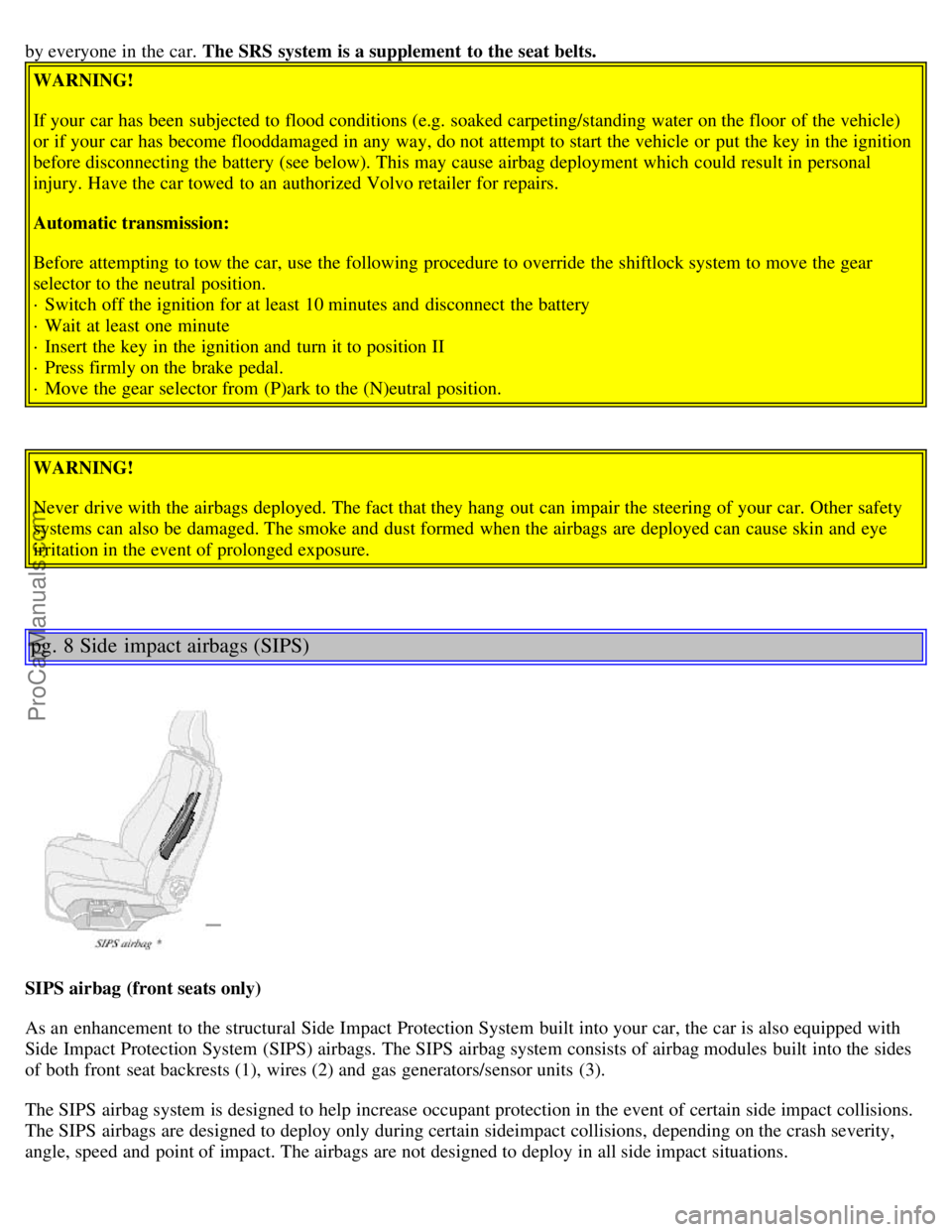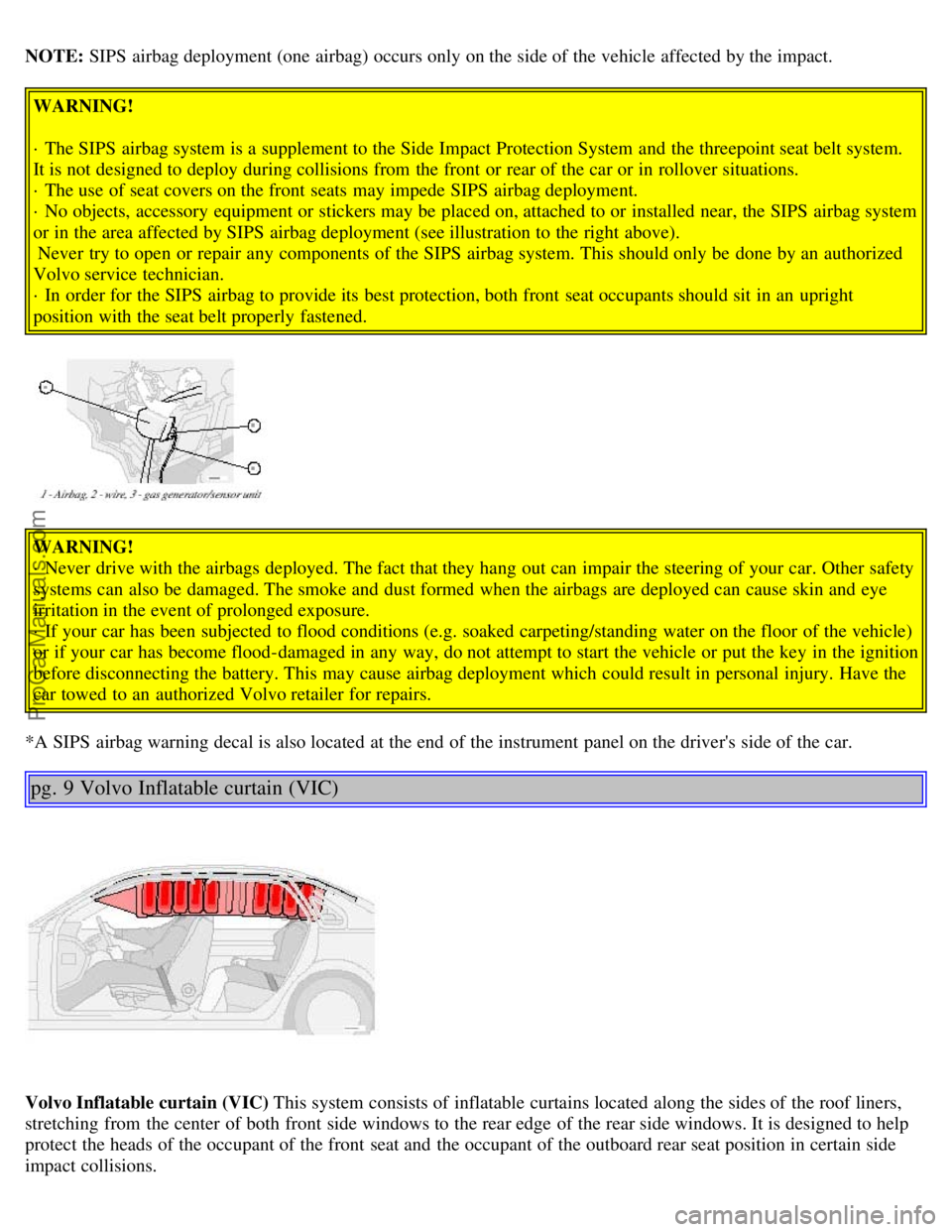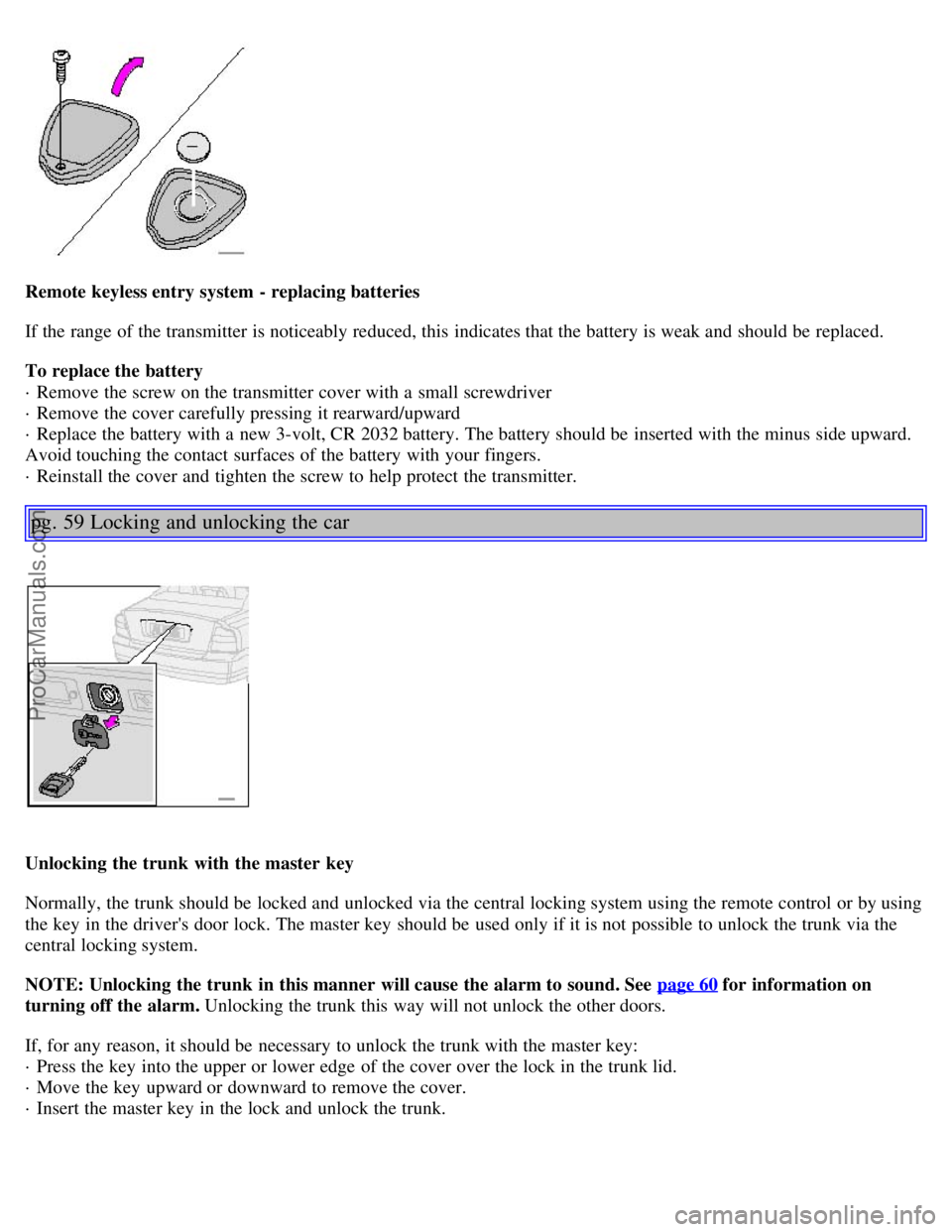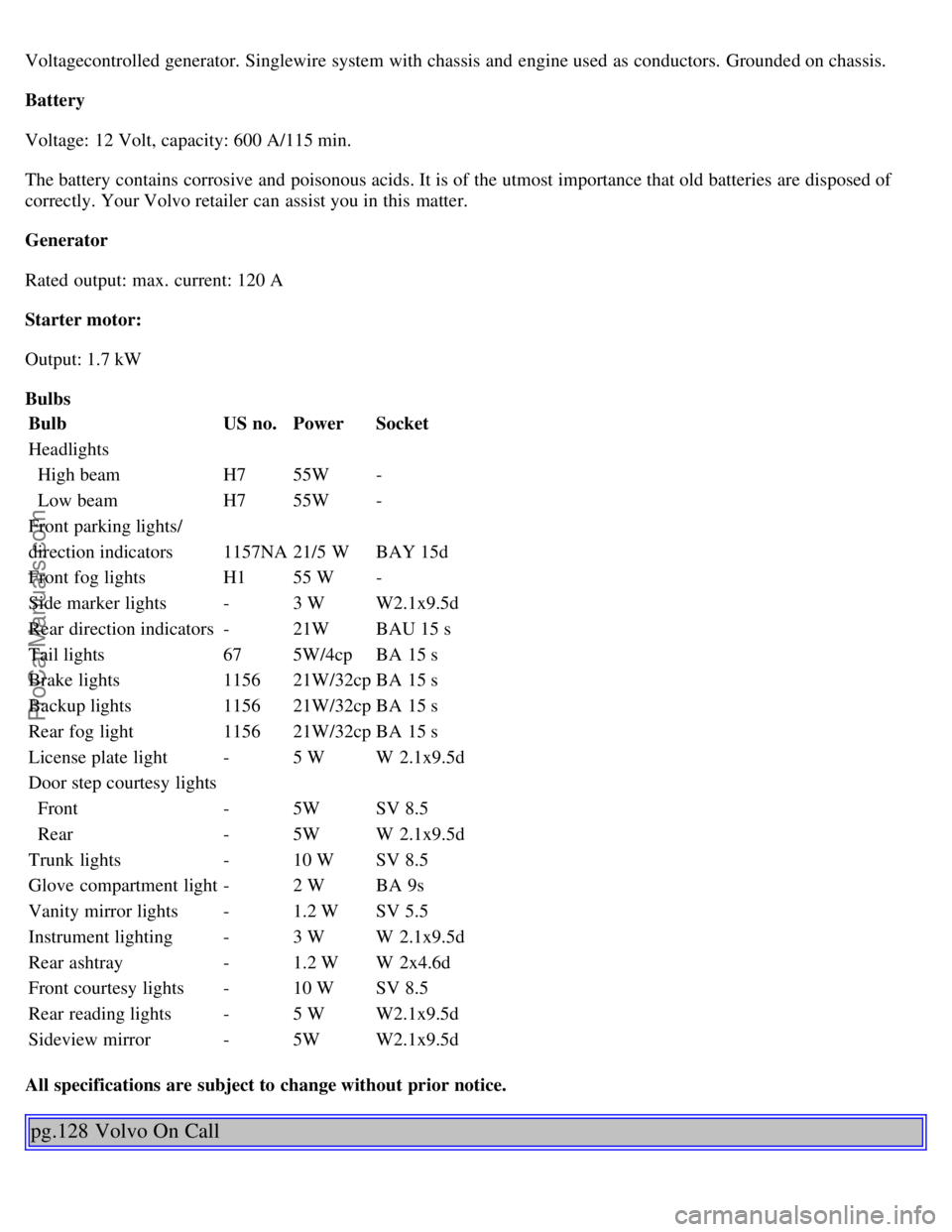2001 VOLVO S80 battery
[x] Cancel search: batteryPage 12 of 106

by everyone in the car. The SRS system is a supplement to the seat belts.
WARNING!
If your car has been subjected to flood conditions (e.g. soaked carpeting/standing water on the floor of the vehicle)
or if your car has become flooddamaged in any way, do not attempt to start the vehicle or put the key in the ignition
before disconnecting the battery (see below). This may cause airbag deployment which could result in personal
injury. Have the car towed to an authorized Volvo retailer for repairs.
Automatic transmission:
Before attempting to tow the car, use the following procedure to override the shiftlock system to move the gear
selector to the neutral position.
· Switch off the ignition for at least 10 minutes and disconnect the battery
· Wait at least one minute
· Insert the key in the ignition and turn it to position II
· Press firmly on the brake pedal.
· Move the gear selector from (P)ark to the (N)eutral position.
WARNING!
Never drive with the airbags deployed. The fact that they hang out can impair the steering of your car. Other safety
systems can also be damaged. The smoke and dust formed when the airbags are deployed can cause skin and eye
irritation in the event of prolonged exposure.
pg. 8 Side impact airbags (SIPS)
SIPS airbag (front seats only)
As an enhancement to the structural Side Impact Protection System built into your car, the car is also equipped with
Side Impact Protection System (SIPS) airbags. The SIPS airbag system consists of airbag modules built into the sides
of both front seat backrests (1), wires (2) and gas generators/sensor units (3).
The SIPS airbag system is designed to help increase occupant protection in the event of certain side impact collisions.
The SIPS airbags are designed to deploy only during certain sideimpact collisions, depending on the crash severity,
angle, speed and point of impact. The airbags are not designed to deploy in all side impact situations.
ProCarManuals.com
Page 13 of 106

NOTE: SIPS airbag deployment (one airbag) occurs only on the side of the vehicle affected by the impact.
WARNING!
· The SIPS airbag system is a supplement to the Side Impact Protection System and the threepoint seat belt system.
It is not designed to deploy during collisions from the front or rear of the car or in rollover situations.
· The use of seat covers on the front seats may impede SIPS airbag deployment.
· No objects, accessory equipment or stickers may be placed on, attached to or installed near, the SIPS airbag system
or in the area affected by SIPS airbag deployment (see illustration to the right above).
Never try to open or repair any components of the SIPS airbag system. This should only be done by an authorized
Volvo service technician.
· In order for the SIPS airbag to provide its best protection, both front seat occupants should sit in an upright
position with the seat belt properly fastened.
WARNING!
· Never drive with the airbags deployed. The fact that they hang out can impair the steering of your car. Other safety
systems can also be damaged. The smoke and dust formed when the airbags are deployed can cause skin and eye
irritation in the event of prolonged exposure.
· If your car has been subjected to flood conditions (e.g. soaked carpeting/standing water on the floor of the vehicle)
or if your car has become flood-damaged in any way, do not attempt to start the vehicle or put the key in the ignition
before disconnecting the battery. This may cause airbag deployment which could result in personal injury. Have the
car towed to an authorized Volvo retailer for repairs.
*A SIPS airbag warning decal is also located at the end of the instrument panel on the driver's side of the car.
pg. 9 Volvo Inflatable curtain (VIC)
Volvo Inflatable curtain (VIC) This system consists of inflatable curtains located along the sides of the roof liners,
stretching from the center of both front side windows to the rear edge of the rear side windows. It is designed to help
protect the heads of the occupant of the front seat and the occupant of the outboard rear seat position in certain side
impact collisions.
ProCarManuals.com
Page 43 of 106

Remote keyless entry system - replacing batteries
If the range of the transmitter is noticeably reduced, this indicates that the battery is weak and should be replaced.
To replace the battery
· Remove the screw on the transmitter cover with a small screwdriver
· Remove the cover carefully pressing it rearward/upward
· Replace the battery with a new 3-volt, CR 2032 battery. The battery should be inserted with the minus side upward.
Avoid touching the contact surfaces of the battery with your fingers.
· Reinstall the cover and tighten the screw to help protect the transmitter.
pg. 59 Locking and unlocking the car
Unlocking the trunk with the master key
Normally, the trunk should be locked and unlocked via the central locking system using the remote control or by using
the key in the driver's door lock. The master key should be used only if it is not possible to unlock the trunk via the
central locking system.
NOTE: Unlocking the trunk in this manner will cause the alarm to sound. See page 60
for information on
turning off the alarm. Unlocking the trunk this way will not unlock the other doors.
If, for any reason, it should be necessary to unlock the trunk with the master key:
· Press the key into the upper or lower edge of the cover over the lock in the trunk lid.
· Move the key upward or downward to remove the cover.
· Insert the master key in the lock and unlock the trunk.
ProCarManuals.com
Page 45 of 106

The alarm is automatically set (armed) whenever you lock your car.
When armed (set), the alarm continuously monitors a number of points on the car. The following conditions will set off
the alarm:
· The hood is forced opened.
· The trunk is forced opened.
· A door is forced opened.
· The ignition switch is tampered with.
· If there is movement in the passenger compartment (if the car is equipped with the optional movement sensor).
· The car is lifted or towed (if the car is equipped with the optional inclination sensor).
· The battery is disconnected (while the alarm is set).
Arming (setting) the alarm
Press the LOCK button on the remote control, lock the car using the key in the driver's door or press the central lock
button on one of the front doors with the door open. One long flash of the turn signals will confirm that the alarm is
set.
Disarming the alarm
Press the UNLOCK button on the remote control or unlock the doors with the key.
Turning off (stopping) the alarm
If the alarm is sounding, it can be stopped by pressing the UNLOCK button on the remote control or by unlocking the
driver's door with the key.
Visual alarm signal
The visual alarm signal is given by flashing all turn signals and turning on the interior lighting for approximately 5
minutes.
Audible alarm signal
An audible alarm signal is given by a battery powered siren. One alarm cycle lasts for 25 seconds.
"Panic" function
In an emergency situation, this feature can be used to attract attention.
Activate the "panic" function by pressing the red button on the remote control (see illustration on page 57
) for at least
3 seconds or by pressing this button twice within 3 seconds. The turn signals will flash, the interior lights will go on
and the car's horn will sound.
The function can be turned off by pressing any of the buttons on the remote control or will stop automatically
after 25 seconds. When a button is pressed, there is a 5 second delay before the panic alarm is deactivated.
NOTE: This button will NOT unlock the car.
pg. 61 Alarm
ProCarManuals.com
Page 66 of 106

2 0 0 1
VOLVO S80
Chapter 8 - Maintenance/Servicing
pg.91 Maintenance/Servicing
Fuses92
Replacing bulbs96
Paint touch up103
Washing the car104
Cleaning the upholstery105
Maintenance service, Warranty106
Maintenance schedule107
Fuel/emissions systems109
Drive belt, Air pump system, Coolant110
Servicing111
Opening the hood, Engine compartment113
Engine oil114
Power steering/Brake fluid reservoirs116
Battery maintenance117
Replacing wiper blades119
pg.92 Fuses
ProCarManuals.com
Page 84 of 106

Voltagecontrolled generator. Singlewire system with chassis and engine used as conductors. Grounded on chassis.
Battery
Voltage: 12 Volt, capacity: 600 A/115 min.
The battery contains corrosive and poisonous acids. It is of the utmost importance that old batteries are disposed of
correctly. Your Volvo retailer can assist you in this matter.
Generator
Rated output: max. current: 120 A
Starter motor:
Output: 1.7 kW
BulbsBulb US no.Power Socket
Headlights
ProCarManuals.com
Page 99 of 106

..Geartronic..........69, 70
..Kickdown..........69
..Specifications..........124
Auxiliary socket..........27, 34
B
Backrests, rear seat - folding..........54
Battery..........80, 127
Battery maintenance..........117, 118
Replacing the battery..........118
Ventilation hose..........118
Blinds - rear/side rear windows..........38
Booster cushion..........13, 15
Booster cushion - integrated..........13
Brake failure warning light ..........24
Brake fluid..........116, 125
Brake system..........16
Break-in period..........64
Bulbs (list)..........127
Bulbs - replacing..........96-102
C
Capacities (oils and fluids)..........121
, 125
Cargo net in trunk..........53
Catalytic converters - three-way..........82
Center console - switches..........27
Center head restraint - rear seat..........3
Central locking buttons..........59
Chains - winter driving..........85
Changing wheels..........88, 89
Child booster cushion ......... 13, 15
Child restraint anchorages ........ 12
Child safety..........12, 13, 14, 15
Child safety locks - rear doors..........62
Climate controls..........41, 42, 43, 45
Climate system - general information..........44
Clock..........23
Coat hanger..........49
Cold weather driving..........80
Combination filter..........41, 45
Coolant..........110, 125
Cooling system..........71, 125
Courtesy light..........50
Courtesy lights (front) - replacing..........102
Courtesy lights - exterior..........56
Cruise control..........29
ProCarManuals.com